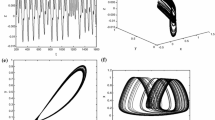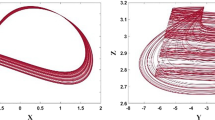Abstract
Lag synchronization of multiple identical Hindmarsh–Rose neuron systems coupled in a ring structure is investigated. In the coupled systems, each neuron receives signals only via synaptic strength from the nearest neighbors. Based on the Lyapunov stability theory, the sufficient conditions for synchronization of the multiple systems with chaotic bursting behavior can be obtained. The synchronization condition about the control parameter g is also obtained by numerical method. Finally, numerical simulations are provided to show the effectiveness of the developed methods.
Similar content being viewed by others
References
Gerstner, W., Kistler, W.M.: Spiking Neuron Models. Cambridge University Press, Cambridge (2002)
Carroll, T.L., Pecora, L.M.: Synchronization in chaotic systems. Phys. Rev. Lett. 64, 821–824 (1990)
Lu, J., Cao, J.: Adaptive complete synchronization of two identical or different chaotic (hyperchaotic) dynamical systems with fully unknown parameters. Chaos 15, 043901-10 (2005)
Ghosh, D.: Nonlinear-observer-based synchronization scheme for multiparameter estimation. Europhys. Lett. 84, 40012-4 (2008)
Wang, Z.L.: Anti-synchronization in two non-identical hyperchaotic systems with known or unknown parameters. Commun. Nonlinear Sci. Numer. Simul. 14, 2366–2372 (2009)
Ghosh, D., Banerjee, S.: Adaptive scheme for synchronization-based multiparameter estimation from a single chaotic time series and its applications. Phys. Rev. E 78, 056211-5 (2008)
Meister, M., Wong, R.O., Baylor, D.A., Shatz, C.J.: Synchronous bursts of action potentials in ganglion cells of the developing mammalian retina. Science 252, 939–943 (1991)
Kreiter, A.K., Singer, W.: Stimulus-dependent synchronization of neuronal responses in the visual cortex of the awake macaque monkey. J. Neurons 16, 2381–2396 (1996)
Garbo, A.D., Barbi, M., Chillemi, S.: The synchronization properties of a network of inhibitory interneurons depend on the biophysical model. BioSystems 88, 216–227 (2007)
Ma, J., Wang, Q.Y., Jin, W.Y., Xia, Y.F.: Control chaos in the Hindmarsh–Rose neuron by using intermittent feedback with one variable. Chin. Phys. Lett. 25(10), 3582–3585 (2008)
Wang, W., Perez, G., Cerdeira, H.A.: Dynamical behavior of the firings in a coupled neuronal system. Phys. Rev. E 47, 2893–2898 (1993)
Sabbagh, H.: Control of chaotic solutions of the Hindmarsh–Rose equations. Chaos Solitons Fractals 11, 1213–1218 (2000)
Ma, J., Jia, Y., Tang, J., Yang, L.: Breakup of spiral waves in the coupled Hindmarsh–Rose neurons. Chin. Phys. Lett. 25(12), 4325–4328 (2008)
Yu, H., Peng, J.: Chaotic synchronization and control in nonlinear-coupled Hindmarsh–Rose neural systems. Chaos Solitons Fractals 29, 342–348 (2006)
Belykh, I., de Lange, E., Hasler, M.: Synchronization of bursting neurons: what matters in the network topology. Phys. Rev. Lett. 94, 188101-4 (2005)
Ma, J., Ying, H.P., Liu, Y., Li, S.R.: Development and transition of spiral wave in the coupled Hindmarsh–Rose neurons in two-dimensional space. Chin. Phys. B 18(1), 98–105 (2009)
Shuai, J.W., Durand, D.M.: Phase synchronization in two coupled chaotic neurons. Phys. Lett. A 264, 289–296 (1999)
Ivanchenko, M.V., Osipov, G.V., Shalfeev, V.D., Krths, J.: Phase synchronization in ensembles of bursting oscillators. Phys. Rev. Lett. 93, 134101-4 (2004)
Wang, Q.Y., Lu, Q.S.: Phase synchronization in small-world chaotic neural networks. Chin. Phys. Lett. 22, 1329–1332 (2005)
Wang, H.X., Lu, Q.S., Wang, Q.Y.: Complete synchronization in coupled chaotic HR neurons with symmetric coupling schemes. Chin. Phys. Lett. 22, 2173–2175 (2005)
Yoshioka, M.: Chaos synchronization in gap–junction-coupled neurons. Phys. Rev. E 71, 065203-4 (2005)
Wang, Q.Y., Lu, Q.S., Chen, G.R., Guo, D.H.: Chaos synchronization of coupled neurons with gap junctions. Phys. Lett. A 356, 17–25 (2006)
Shi, X., Lu, Q.S.: Rhythm synchronization of coupled neurons with temporal coding scheme. Chin. Phys. Lett. 24, 636–639 (2007)
Wang, Q.Y., Lu, Q.S., Chen, G.R.: Ordered bursting synchronization and complex wave propagation in a ring neuronal network. Phys. A 374, 869–878 (2007)
Zheng, Y.H., Lu, Q.S.: Spatiotemporal patterns and chaotic burst synchronization in a small-world neuronal network. Phys. A 387, 3719–3728 (2008)
Hindmarsh, J.L., Rose, R.M.: A model of the nerve impulse using two first-order differential equations. Nature 296, 162–164 (1982)
Author information
Authors and Affiliations
Corresponding author
Rights and permissions
About this article
Cite this article
Wang, Z., Shi, X. Lag synchronization of multiple identical Hindmarsh–Rose neuron models coupled in a ring structure. Nonlinear Dyn 60, 375–383 (2010). https://doi.org/10.1007/s11071-009-9602-0
Received:
Accepted:
Published:
Issue Date:
DOI: https://doi.org/10.1007/s11071-009-9602-0




